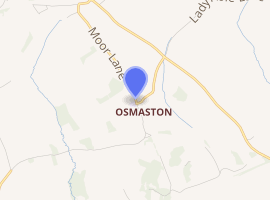St Martin's Church, Osmaston
St Martin's Church, Osmaston is a Grade II* listed parish church in the Church of England[3]:295 in Osmaston, Derbyshire Dales.
| St Martin’s Church, Osmaston | |
|---|---|
 St Martin’s Church, Osmaston | |

| |
| 52°59′34.67″N 1°42′17.92″W | |
| Location | Osmaston, Derbyshire Dales |
| Country | England |
| Denomination | Church of England |
| History | |
| Dedication | St Martin |
| Consecrated | 23 June 1845 |
| Architecture | |
| Heritage designation | Grade II* listed[1] |
| Architect(s) | Henry Isaac Stevens |
| Groundbreaking | 8 June 1843 |
| Completed | 23 June 1845 |
| Specifications | |
| Length | 94 feet (29 m) |
| Width | 45.2 feet (13.8 m) |
| Nave width | 18 feet (5.5 m) |
| Height | 69 feet (21 m) |
| Administration | |
| Parish | Osmaston |
| Deanery | Ashbourne[2] |
| Archdeaconry | Derby |
| Diocese | Derby |
| Province | Canterbury |
History
The original church may have dated from 1606. The first stone of the new church was laid on 8 June 1843. and it was designed by Henry Isaac Stevens of Derby. It consists of a nave, aisles, chancel, west tower, south porch and vestry. The external stone for the walls is limestone from land owned by Henry FitzHerbert, 3rd Baronet of Tissington, and other stone from the quarries at Stanton near Ashbourne was used for the windows, doors, buttresses, and moulded and ornamental portions. The builder was William Evans of Ellastone, Ashbourne.
The £9,000 (equivalent to £896,900 in 2019)[4] cost of rebuilding plus the attached school-rooms was funded by Francis Wright of Lenton, Nottingham, and the church was consecrated by the Bishop of Lichfield, Rt. Revd. John Lonsdale on 23 June 1845.[5]
War memorial
The churchyard contains a Grade II listed[6] war memorial of 1921 by Walter Shirley, 11th Earl Ferrers.
Parish status
The church is in a joint parish with
Organ
The church contains a pipe organ which was obtained in 2000 from the United Reformed Church, Ashbourne. It was installed within the casework of the previous Brindley & Foster organ. A specification of the current organ can be found on the National Pipe Organ Register.[7]
Bells
The church tower contains a peal of 6 bells, 5 of them dating from 1845 by Charles and George Mears. The treble dates from 1914 and was cast by Mears and Stainbank.[8]
References
- Historic England, "Church of St Martin (1335071)", National Heritage List for England, retrieved 8 January 2017
- "St Martin, Osmaston". A Church Near You. The Church of England. Retrieved 8 January 2017.
- Pevsner, Nikolaus; Williamson, Elizabeth (1979). The Buildings of England. Derbyshire. Penguin Books Limited. ISBN 0140710086.
- UK Retail Price Index inflation figures are based on data from Clark, Gregory (2017). "The Annual RPI and Average Earnings for Britain, 1209 to Present (New Series)". MeasuringWorth. Retrieved February 2, 2020.
- "Consecration of Osmaston Church". Derbyshire Courier. England. 28 June 1845. Retrieved 8 January 2017 – via British Newspaper Archive.
- Historic England, "War Memorial south west of church of St Martin (1335053)", National Heritage List for England, retrieved 8 January 2017
- "NPOR R00020". National Pipe Organ Register. British Institute of Organ Studies. Retrieved 8 January 2017.
- "Osmaston, Derby. S Martin". Dove's Guide for Church Bell Ringers. Dovemaster. 6 December 2006. Retrieved 8 January 2017.